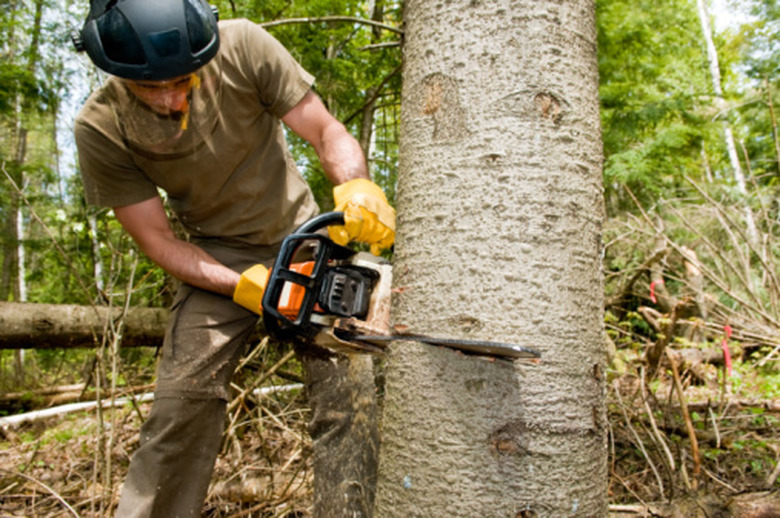Tree Cutting Techniques & Types Of Cuts
The techniques used to fell any tree safely depend on the surrounding terrain, and the shape and size of the tree. Two basic types of cut are designed to control the direction in which the tree will fall. The specific angles of these cuts and where they are made on the tree depend on the specific characteristics of each tree.
Cutting Conditions
The technique you use to cut down a tree depends on the type of tree, how it has grown and the terrain around the tree. Certain types of tree, willow for example, are more likely to split and break apart when they fall. Trees that are leaning or growing on a slope require specific cutting techniques to control their direction of fall safely. Other factors, such as rot or other damage to the tree, also have an impact on how the tree is cut.
- The techniques used to fell any tree safely depend on the surrounding terrain, and the shape and size of the tree.
- The technique you use to cut down a tree depends on the type of tree, how it has grown and the terrain around the tree.
Face Cut
The first types of cut used to fell trees are a pair of cuts designed to control the rate and direction of the tree's fall. The face cut takes a wedge of wood from the side of the tree facing the direction that you intend for it to fall. There are several ways to make a face cut, but the most basic method uses one downward angled cut that meets a separate horizontal cut, forming a wedge. These relatively shallow cuts should not go deeper than one third of the diameter of the trunk.
Back Cut
The back cut is the second type of cut, made after the face cut is complete. This cut is made horizontally from the other side of the tree, roughly two inches above the notch left by the face cut. The back cut should stop before completely cutting through the tree, leaving approximately an inch of wood. The wood that is not cut is referred to as the hingewood. The angle of the backcut determines the shape of the hingewood, which affects the direction in which the tree will fall. A wide angled backcut will produce triangular-shaped hingewood, which causes the tree to fall away from the narrow end of the hingewood.
- The first types of cut used to fell trees are a pair of cuts designed to control the rate and direction of the tree's fall.
- This cut is made horizontally from the other side of the tree, roughly two inches above the notch left by the face cut.
Advanced Techniques
Trees with a wide diameter often require multiple cuts to create a proper backcut. The quartering technique creates the backcut using two separate cuts at the same height and angle that combine to span the width of the tree. After making the first half of the backcut, a wedge is used to prevent the weight of the tree from shifting and changing the angle of its fall. Trees that are leaning, located on hill sides or have odd shapes often require use of a combination of wedges and changes to the angle of the face cut or backcut to control the tree's fall safely.
Safety Techniques
Several basic safety techniques should always be used when felling a tree. Always plan at least two obstruction-free paths away from the tree you are cutting. When you are creating the face cut, make sure that both cuts meet evenly and do not overlap. Overextending one of these cuts further into the tree can cause it to fall towards you. Always make the backcut slightly above the point where the two cuts of the face cut meet. A backcut that is made too deeply or below the face cut can cause the tree to fall towards you or trap your saw. A backcut made at the same level as the notch in the face cut can cause the base of the tree to bounce towards you as it falls. Using the proper techniques and understanding how to apply them to individual trees is the key to felling any tree safely.
- Trees with a wide diameter often require multiple cuts to create a proper backcut.
- Trees that are leaning, located on hill sides or have odd shapes often require use of a combination of wedges and changes to the angle of the face cut or backcut to control the tree's fall safely.
